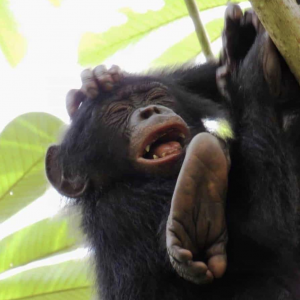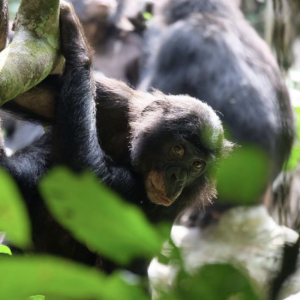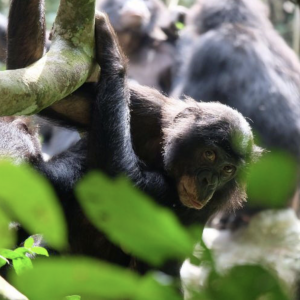Researchers have successfully adapted a standardized system for analyzing facial expressions to include bonobos
The Facial Action Coding System (FACS) is a widely recognised coding scheme for analysing human facial behaviour, providing an objective method to quantify discrete movements associated with facial muscles, known as Action Units (AUs), and reducing subjective bias. FACS has been adapted for nine other taxa, including apes, macaques, and domestic animals, but not yet bonobos. To carry out cross species studies of facial behaviours within and beyond apes, it is essential to include bonobos.
In the Press

System adapted: Researchers now able to precisely analyse bonobo facial expressions

System adapted: Researchers now able to precisely analyse bonobo facial expressions
My Science
.

Facial expressions of bonobos offer a window into their lives
“This adaptation of ChimpFACS for bonobos fills an important gap in our ability to study facial expressions across different primate species,” explains lead researcher Dr. Catia Correia-Caeiro.
For All Readers - AI Explainer
Understanding Bonobo Facial Expressions: The ChimpFACS Extension for Bonobos
Facial expressions are a crucial part of communication for many species, including our closest living relatives – chimpanzees and bonobos. Recent research has expanded our ability to study these expressions scientifically. Let’s explore the fascinating world of bonobo facial expressions through this Q&A about groundbreaking research extending the Facial Action Coding System to bonobos.
What is the Facial Action Coding System (FACS)?
FACS is a standardized method for objectively analyzing facial movements. Rather than subjectively interpreting expressions as “happy” or “angry,” FACS breaks down facial movements into discrete Action Units (AUs) linked to specific facial muscles. For example, when you smile, FACS doesn’t label it as “happiness” but instead codes the specific muscle movements involved, such as AU12 (lip corner puller). This approach reduces subjective bias and allows for precise measurement of facial behavior.
Why was it important to extend FACS to bonobos?
While FACS has been adapted for nine other species including chimpanzees, macaques, and domestic animals, bonobos were a missing piece of the puzzle. As one of our closest living relatives (along with chimpanzees), understanding bonobo facial expressions is crucial for comparative studies across primate species. This research fills that gap, allowing scientists to conduct comprehensive cross-species studies of facial behaviors within and beyond apes, which helps us better understand the evolution of facial communication.
How did researchers adapt FACS for bonobos?
The researchers followed a three-step approach:
- They examined previously published dissections of bonobo facial musculature to understand the anatomical basis for facial movements.
- Since bonobo and chimpanzee facial muscles are very similar, they tested whether ChimpFACS (the version developed for chimpanzees) could be applied to bonobos by analyzing videos of spontaneous bonobo facial behavior in various contexts.
- They documented any differences in appearance changes between chimpanzees and bonobos for each Action Unit.
What did the researchers discover about bonobo facial expressions?
The study revealed that bonobos exhibit all the facial movements observed in chimpanzees, confirming that ChimpFACS can be reliably applied to bonobos with some specific adaptations. In total, bonobos display 28 facial movements:
- 22 Action Units (AUs) linked to specific facial muscles
- 3 Action Descriptors (ADs) for broader movements
- 3 Ear Action Descriptors (EADs) for ear movements
While bonobos show fewer facial movements than humans, their facial movement repertoire is comparable to chimpanzees, highlighting the importance of facial communication in both species’ social interactions.
Can bonobos make facial expressions that chimpanzees cannot?
The research found that bonobos can produce all the facial movements that chimpanzees can. The researchers didn’t identify any unique facial movements in bonobos that aren’t present in chimpanzees. This similarity reflects their close evolutionary relationship and comparable facial musculature.
How reliable is the new coding system for bonobos?
The researchers conducted inter-rater reliability tests to ensure the coding system could be consistently applied. Multiple trained coders analyzed the same facial movements independently, and their results were compared to verify consistency. The details of these reliability tests are included in the supplementary materials of the research paper, confirming that the ChimpFACS Extension for bonobos is a reliable tool for scientific research.
What are the practical applications of this research?
This extension of ChimpFACS to bonobos has several important applications:
- Welfare Assessment: It provides an objective tool for evaluating bonobo welfare, particularly for those in human care, by monitoring their facial expressions.
- Communication Research: It enables more detailed studies of bonobo communication and social behavior.
- Evolutionary Insights: By comparing facial expressions across primate species, researchers can gain valuable insights into the origins and evolution of emotional expression and communication.
- Cross-Species Comparisons: The standardized coding system allows for direct comparisons between humans, chimpanzees, bonobos, and other species with FACS adaptations.
What’s next for facial expression research in primates?
With the ChimpFACS Extension for bonobos now available, researchers can conduct more comprehensive studies comparing facial expressions across the great apes. This will help answer questions about how facial communication evolved in our primate ancestors and what features might be uniquely human versus shared with our closest relatives.
What are Article Spotlights?
Spotlighted articles are press released, and feature author interviews, AI explainers and more.
If you have published in Peer J and would like to be featured in an Article Spotlight please contact PeerJ.


